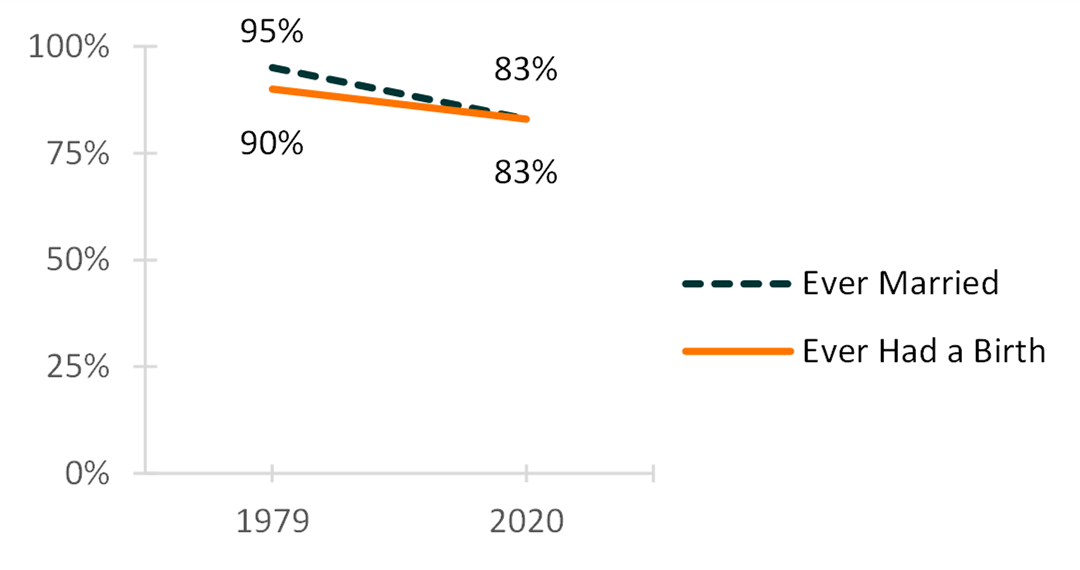Forty Years of Change in Marriage and Motherhood Among Women, 1979 & 2020
Family Profile No. 19, 2022
Author: Adrianne R. Brown
Over the past several decades, marriage has been increasingly postponed or forgone, while childbearing outside of marriage has become more common (FP-21-24, FP-21-17, FP-21-12). The current profile uses data from the 1979 and 2020 Fertility Supplement of the Current Population Survey to examine differences in the share of women who ever married and the share who ever had a birth by the end of their childbearing years (defined as ages 40-44). This represents the experiences of women born between 1935 and 1939 (part of the Silent Generation) and women born between 1976 and 1980 (part of Gen-X). We consider overall trends and disaggregate by race/ethnicity and by educational attainment.
Changes in the Shares of Women Who Married and Had a Birth
- In 1979, 95% of women aged 40-44 had ever married and 90% had ever had a birth.
- Both the share of women who had married and the share of women who had a birth decreased between 1979 and 2020, such that both shares equaled 83% in 2020. The decline in marriage was greater than the decline in motherhood.
Figure 1. Shares of Women Aged 40-44 Who Ever Married and Had a Birth in 1979 & 2020

Race/Ethnicity
Trends in the share of women who had ever married and the share who had a birth varied by race/ethnicity.
- The share of White women who had ever married declined from 96% in 1979 to 85% in 2020. Among the three racial/ethnic groups examined, White women experienced the greatest decline in the share who had a birth (from 90% in 1979 to 81% in 2020).
- Black women experienced a small decline in the share who had a birth and a large decline in the share who had ever married.
- In 1979, both the share who had married and the share who had a birth was 89%. In 2020, 82% of Black women aged 40-44 had ever had a birth, while just 64% had ever married.
- In 1979, a greater share of Hispanic women had married than had a birth (93% and 88%, respectively). This pattern had reversed by 2020, such that 85% had married and 90% had a birth.
Figure 2. Shares of Women Aged 40-44 Who Ever Married and Had a Birth in 1979 & 2020 by Race/Ethnicity

Educational Attainment
In 1979, the share of women who had married was greater than the share who had a birth across all four education groups. By 2020, this was only true among women with a bachelor’s degree or more.
- The share ever married declined across all education groups. The decline in marriage was greatest among those with a high school diploma or equivalent (96% to 75%) and smallest among women with a college degree.
- The share of women who had a birth decreased among those in the middle education groups (high school and some college) while this share increased slightly among those in the lowest and highest educational attainment groups (less than high school and bachelor’s degree or more).
Figure 3. Shares of Women Aged 40-44 Who Ever Married and Had a Birth in 1979 & 2020 by Educational Attainment


Data Source:
Flood, S., King, M., Rodgers, R., Ruggles, S., Warren, J. R., & Westberry, M. (2021). Integrated Public Use Microdata Series: Current Population Survey: Version 9.0 [dataset]. Minneapolis, MN: IPUMS. https://doi.org/10.18128/D030.V9.0
References:
Guzzo, K. B. (2021). Trends in births to single and cohabiting mothers under 40, 1980-2018. Family Profiles, FP-21-17. Bowling Green, OH: National Center for Family & Marriage Research. https://doi.org/10.25035/ncfmr/fp-21-17
Payne, K. K. (2021). Marital experiences in the U.S., 1996 & 2018. Family Profiles, FP-21-24. Bowling Green, OH: National Center for Family & Marriage Research. https://doi.org/10.25035/ncfmr/fp-21-24
Payne, K. K. (2021). Median age at first marriage, 2020. Family Profiles, FP-21-12. Bowling Green, OH: National Center for Family & Marriage Research. https://doi.org/10.25035/ncfmr/fp-21-12
Suggested Citation:
Brown, A. R. (2022). Forty years of change in marriage and motherhood among women, 1979 & 2020. Family Profiles, FP-22-19. Bowling Green, OH: National Center for Family & Marriage Research. https://doi.org/10.25035/ncfmr/fp-22-19
Updated: 11/07/2025 02:53PM


